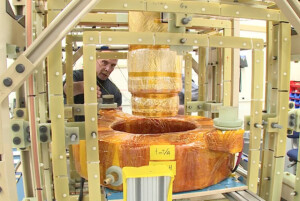by
Lauren Dubinsky, Senior Reporter | April 23, 2015

Courtesy of Los Alamos
National Laboratory
The Los Alamos National Laboratory is currently working on creating an ultra-low-field MRI called Battlefield MRI (bMRI) that is lightweight and low-power enough to be used in emerging countries and on the battlefield. Right now, MRIs are not deployed in those settings because of the machines' large size and expensive price tag.
"Standard MRI machines just can't go everywhere," Michelle Espy, the bMRI project leader, said in a statement. "Soldiers wounded in battle usually have to be flown to a large hospital and people in emerging nations just don't have access to MRI at all.”
The traditional MRI systems use large magnetic fields to generate very detailed images. Espy and her team of scientists wanted to determine if ultra-low-magnetic fields, comparable to the strength of the Earth’s magnetic field, would produce images of sufficient quality.



Ad Statistics
Times Displayed: 173485
Times Visited: 3165 For those who need to move fast and expand clinical capabilities -- and would love new equipment -- the uCT 550 Advance offers a new fully configured 80-slice CT in up to 2 weeks with routine maintenance and parts and Software Upgrades for Life™ included.
In order to produce the images at such low fields, they used detectors called Superconducting Quantum Interference Devices (SQUIDS). SQUIDS are one of the most sensitive magnetic detectors, so the major challenge involved is interference with the signal.
Since the detectors are so sensitive that a truck driving outside or a radio signal 50 miles away will interfere with it, bMRI has to be built in a big metal housing that shielded it from the interferences. But now thanks to a lightweight series of wire coils around the bMRI, the scientists can work on it in an open environment.
"We've been very happy with some of the initial imagery that's been produced from the lightweight, second generation system," Espy, said in a statement. "It really shows that, with additional development, these systems could be relatively easy and inexpensive to deploy."

